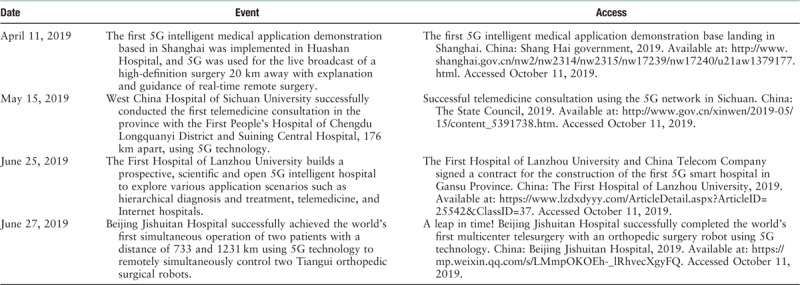To the Editor: With the start of the China-US trade war, the Trump administration signed the Fiscal Year 2019 Defense Authorization Act, restricting the use of 5G in the United States by companies such as Huawei. This is obviously contrary to global integration. 5G network comprehensive performance is up to 100 times than 4G, with ultrahigh data rate, low delay, high mobility, high energy efficiency, and other characteristics.[1] Countries actively apply 5G technology to telemedicine, emergency rescue, and other fields. In September 2019, with the support of China Mobile 5G, a gastrointestinal surgery department of Barcelona, Spain, safely and effectively implemented telesurgery and telecounseling.[2] Additionally, 5G is changing the present and future of medical health in China.
Premier Li Keqiang, State Council of China, noted that “priority should be given to speeding up telemedicine and using ‘Internet health care’ to make high-quality medical resources more inclusive for the masses,”[3] to improve the level of equalization, universalization, and convenience of the medical industry. On June 6, 2019, China officially issued a 5G commercial license. With the assistance of 5G technology, telemedicine (including cloud data storage and retrieval) is likely to develop at a faster pace; distance is no longer a factor limiting the popularization of high-quality medical resources. China is building a very large 5G medical laboratory network [Table 1].
Table 1.
Application of 5G in some hospitals in China.

It is worthwhile to note that the density of mounted antennas must be increased for proper connection performance.[4] As a result, the spread of radiofrequency electromagnetic fields (RF-EMF) is rising, but the health effects of RF-EMF exposure on humans are not clear.[5] Studies have reported that the global 5G wireless network could threaten weather forecasts.[6]
We believe that 5G technology has greatly shortened the time and space for medical and health services. In the future, wards may no longer be limited to hospitals and quickly introducing only a physician's intelligent devices in real time through information barcodes using 5G networks will be necessary. Specific operations can be performed through remote robots, which greatly reduce the waste and uneven distribution of medical resources.
Conflicts of interest
None.
Footnotes
How to cite this article: Li EL, Wang WJ. 5G will drive the development of health care. Chin Med J 2019;132:2895–2896. doi: 10.1097/CM9.0000000000000534
References
- 1.Chih-Lin I, Han S, Xu Z, Sun Q, Pan Z. 5G: rethink mobile communications for 2020+. Philos Trans A Math Phys Eng Sci 2016; 374:20140432.doi: 10.1098/rsta.2014.0432. [DOI] [PubMed] [Google Scholar]
- 2.Lacy AM, Bravo R, Otero-Pineiro AM, Pena R, De Lacy FB, Menchaca R, et al. 5G-assisted telementored surgery. Br J Surg 2019; 106:1576–1579. doi: 10.1002/bjs.11364. [DOI] [PubMed] [Google Scholar]
- 3.The First 5G intelligent Medical Application Demonstration Base Landing in Shanghai. China: Shang Hai government, 2019. Available at: http://www.shanghai.gov.cn/nw2/nw2314/nw2315/nw17239/nw17240/u21aw1379177.html Accessed October 11, 2019. [Google Scholar]
- 4.Pogue D. 5G is just around the corner. Sci Am 2018; 319:25.doi: 10.1038/scientificamerican1018-25. [DOI] [PubMed] [Google Scholar]
- 5.Di Ciaula A. Towards 5G communication systems: are there health implications? Int J Hyg Environ Health 2018; 221:367–375. doi: 10.1016/j.ijheh.2018.01.011. [DOI] [PubMed] [Google Scholar]
- 6.Witze A. Global 5G wireless networks threaten weather forecasts. Nature 2019; 569:17–18. doi: 10.1038/d41586-019-01305-4. [DOI] [PubMed] [Google Scholar]


